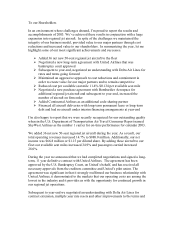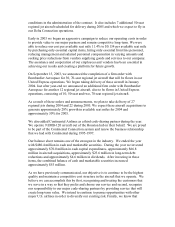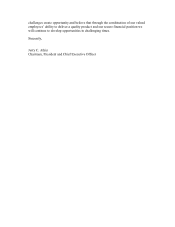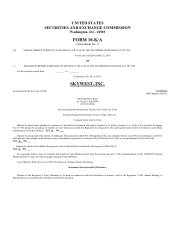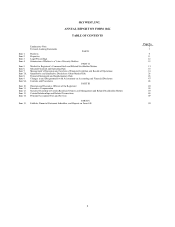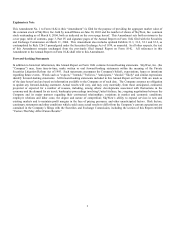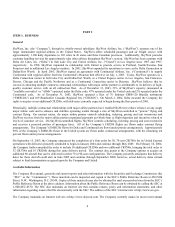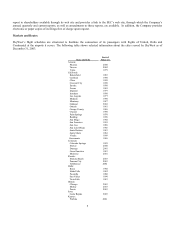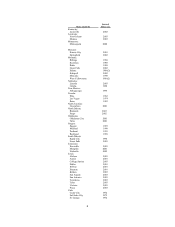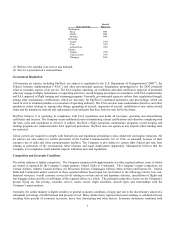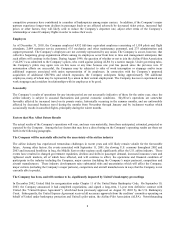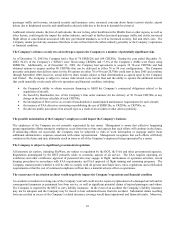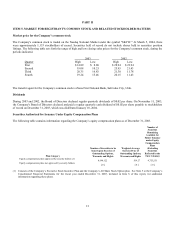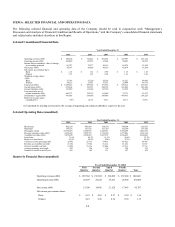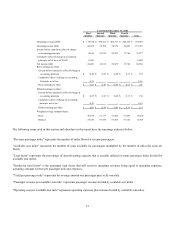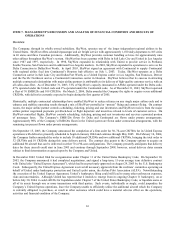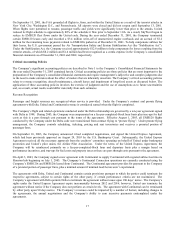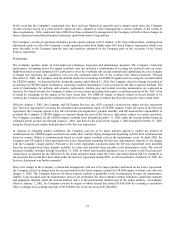SkyWest Airlines 2003 Annual Report Download - page 11
Download and view the complete annual report
Please find page 11 of the 2003 SkyWest Airlines annual report below. You can navigate through the pages in the report by either clicking on the pages listed below, or by using the keyword search tool below to find specific information within the annual report.competitive pressures have contributed to a number of bankruptcies among major carriers. In addition, if the Company’s major
partners experience longer-term declines in passenger loads or are affected adversely by decreased ticket prices, increased fuel
prices or other factors, they will likely seek to reduce the Company’s departure rate, adjust other terms of the Company’s
relationships or cancel Company flights in order to reduce their costs.
Employees
As of December 31, 2003, the Company employed 4,952 full-time equivalent employees consisting of 1,958 pilots and flight
attendants, 2,084 customer service personnel, 635 mechanics and other maintenance personnel, and 275 administration and
support personnel. The Company’s employees are not currently represented by any union. The Company is aware, however, that
collective bargaining group organization efforts among its employees occur from time to time and management anticipates that
such efforts will continue in the future. During August 1999, the question of whether or not to join the Airline Pilots Association
(“ALPA”) was submitted to the Company’s pilots, who voted against joining ALPA by a narrow margin. Under governing rules,
the Company’s pilots may again vote on this issue at any time because one year has passed since the previous vote. If
unionization efforts are successful, the Company may by subjected to risks of work interruption or stoppage and/or incur
additional expenses associated with union representation of its employees. In connection with the Company’s proposed
acquisition of additional CRJ700s and related expansion, the Company anticipates hiring approximately 700 additional
employees, many of whom may be represented by a union in their current employment. The Company has never experienced any
work stoppages and considers its relationships with its employees to be good.
Seasonality
The Company’s results of operations for any interim period are not necessarily indicative of those for the entire year, since the
airline industry is subject to seasonal fluctuations and general economic conditions. SkyWest’s operations are somewhat
favorably affected by increased travel on its prorate routes, historically occurring in the summer months, and are unfavorably
affected by decreased business travel during the months from November through January and by inclement weather which
occasionally results in cancelled flights, principally during the winter months.
Factors that May Affect Future Results
The actual results of the Company’s operations will vary, and may vary materially, from those anticipated, estimated, projected or
expected by the Company. Among the key factors that may have a direct baring on the Company’s operating results are those set
forth in the following paragraphs.
The Company will be materially affected by the uncertainty of the airline industry
The airline industry has experienced tremendous challenges in recent years and will likely remain volatile for the foreseeable
future. Among other factors, the events associated with September 11, 2001, the slowing U.S. economy throughout 2002 and
2003 and increased hostilities in Iraq, the Middle East or other regions could significantly affect the U.S. airline industry. These
events have resulted in changed government regulation, declines and shifts in passenger demand, increased insurance costs and
tightened credit markets, all of which have affected, and will continue to affect, the operations and financial condition of
participants in the industry including the Company, major carriers (including the Company’s major partners), competitors and
aircraft manufacturers. These industry developments raise substantial risks and uncertainties which will affect the Company,
major carriers (including the Company’s major partners), competitors and aircraft manufacturers in ways that the Company is not
currently able to predict.
The Company has been, and will continue to be, significantly impacted by United’s bankruptcy proceedings
In December 2002, United filed for reorganization under Chapter 11 of the United States Bankruptcy Code. On September 10,
2003, the Company announced it had completed negotiations, and signed a long-term, 11-year term definitive contract with
United (the “United Express Agreement”), which had been previously approved on August 29, 2003 by the U.S. Bankruptcy
Court. Subsequently, the United Express Agreement received all necessary approvals from the creditors’ committee operating on
behalf of United under bankruptcy protection and United’s pilot union, the Airline Pilot Association (ALPA). Notwithstanding
8

